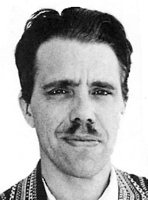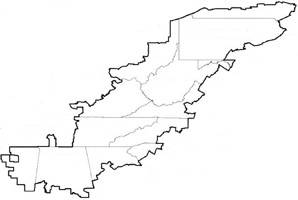
|
The Society of Folk Dance Historians (SFDH)
Appalachian Dance and Music
[
Home |
About |
Encyclopedia | CLICK AN IMAGE TO ENLARGE |

|

 Sometime, somewhere, way back at the dawn of time in the place of men and things, someone squatted, and idly rhythmically, started pounding on an old hollow log – Bong! Bong!
Sometime, somewhere, way back at the dawn of time in the place of men and things, someone squatted, and idly rhythmically, started pounding on an old hollow log – Bong! Bong!
Another someone standing, swayed her body to the right (Bong!) and then to the left (Bong!) and if felt good, so she said, "Hey, look at me – do that again!" So he did and she did and they both agreed it felt good and he thought it looked good for sure and it sounded good too so they tried it again, this time adding an extra Bong! and a bump – and with that one came the first choreography, and so dance was born.
And then through the ages, others found that this dancing stuff felt especially good after a hard day's work – and that following that, if they felt good about this, then they were more able to cope with work on the following day. So, by all means dance, and make it a part of the living scheme and a rite. So work became an excuse for dancing (or maybe it was vice versa, who knows), but anyhow, thus was born the custom of having a celebration following the completion of a task such as harvesting, planting, shepherding, building the communal lodge, or launching the war canoe – and later, barn-raising, hog-sticking, or a wedding (though not necessarily in that order). Such it was in ancient Asia, then Europe and Africa – and, in Appalachia.
Geographically and topographically, Appalachia extends from just over the Maine border into Canada south to the valley and hills surrounding Birmingham, Alabama, but usually in the thought of folklorists, it is the area of Kentucky, the Virginias, Tennessee, North Carolina, and parts of adjacent states, and those areas along the Alleghenies where the mining of coal is the mainstay of life. In fact, coal and mountains and hunger and strikes and cornlikker and dulcimers and dancing are all only too often indiscriminately lumped together in a hodgepodge of thinking.
As it was (and is) in most other parts of the world, with people of strong religious ties, dancing was frowned upon by many elements of the Appalachian society. It was the idle meanderings of the Devil, and one who even attended a dance was doomed to eternal damnation. In some areas, this exists even today. But music and dance are very intergral parts of the life of the of the people in Appalachia, not easy to eradicate. Dance was always a part of the work it took to build a community – raising a cabin roof, completing building a barn (the very first use of a newly completed barn was holding a barn dance!), harvesting, hog butchering, and other things of a nature that entailed a scrabble to exist and a subsequent need to blow off steam following the week's labors. And the song joined the workers together during the times of the strikes just as the fife and drum pulled the soldiers together marching to battle.
Things have changed a lot in Appalachia in recent years of course. Television and rock have made their incursions, young people have shied away from association with their heritage in an effort to avoid the "hillbilly" stereotype thrust upon them. The Western square dance has invaded the area with the fancy costumed sets and the convenient "canned" music. But even more recently, there is beginning a return to the old things, and with the urban interest in things rustic so great, it is even profitable to "go home again."
Of his experiences in researching Appalachian dance in the mountains of Western North Carolina and Eastern Tennessee, Richard Nevell in his "Time to Dance" describes the attitudes of the people, especially in the very remote hill areas of the Great Smokies. He comments that "outsiders," like he was, usually wind up in places like Berea College in Kentucky or the John C. Campbell School in Brasstown, North Carolina where one may get a touch of Appalachian "folk culture" and head home, secure in the knowledge that everybody in that large area makes dulcimers and dances the dances of Appalachia all the time (that is, all the time they're not picketing a coal mine). Both Brasstown and Berea, however, along with the Highlander School in Tennessee and Fontana Village have kept Appalachian dance, music, and song alive and "reachable" to the general folk dance/music public who could never have learned about the Appalachian culture had they to wander over the winding and secret roads looking for elusive villages and crossroads in hidden valleys of those mountainous counties of North Carolina, Tennessee, Kentucky, and the Virginias. Those people there are poor, but proud, and to have a horde of outlanders descending upon them, prying into what they rightfully consider their personal affairs, and it is offensive – to be thought of as "Lil' Abners," even more so.
In quite recent years, clogging has been "discovered" by dancers of Western Squares. It has been around them for some time, but not recognized for what it was, and it was therefore very amusing to read in reports of square dance activities about these new, special workshops in clog dancing at Conventions and Jamborees and clinics. The dance has become very much liked by the square dancers. For that matter, it is fairly new on the international folk dance scene, too, but only in the past few years has it expanded at any pace. This could be in part due to the participation in it by the Carter family. Not the famous country music and dance one from the Clinch River Valley of Southwestern Virginia. I mean the one with the big goober farm down near Plains, Georgia, and living on Pennsylvania Avenue in Washington, DC.
Jerry Duke, assistant Professor of Dance at San Francisco State University in an article for Folk Dance Scene in November, 1973 writes: "Clogging is found throughout the Carolinas, Virginias, and some in Eastern Kentucky, but not often west of the Blue Ridge Continental Divide. In these more northern areas, clogging is done in the 'Big Circle' style, a form apparently derived from the Appalachian square dance. (The Appalachian square is still alive and is often done on the same occasions as the Big Circle clog.) On these occasions it is referred to as 'smooth dance'. California folk dancers sometimes call the smooth dance a 'running set.' This is apparently a misunderstanding of terminology . . ." He goes on to describe the differences between the meaning of big- and little-circle clogs and the Kentucky running set and buck dancing.
Glenn Bannerman, of Richmond, Virginia was the authority on on the Big Circle dances – long time judge and on the staff of the Asheville Festival, and his Bannerman Folk Camp during Thanksgiving in Black Mountain, North Carilina is a very popular fall event. One thing his camp stresses is dancing for children as well as international folk and Appalachian dance. There we find dances such as Skip-to-my-Lou and A-Tisket, A-Tasket – once the only type of dances that could be done in the stern church-loving societies because they were "play party games," not "dancin'," and therefore not "sinful."
Apparently the use of musical instruments was the yardstick by which the amount of sin in a dance was measured. Anyhow, those dances are now back and belonging to the children from whence they probably frist came. Come to think of it, Skip-to-my-Lou was the first folk (or any kind of) dance I ever did in our barnyard after a hog-sticking, less than ten miles from where Glenn lived – while Mother and Dad and their peers did the Waltz and Foxtrot in the house, the older generation the Virginia Reel and eastern Squares in the barn, and the college-age crowd, the Charleston in the hayloft, I think.
DOCUMENTS
- Appalachia, a region.
- Buck and Big Circle Dances of Appalachia, a region.
- Clogging Glossary, an article.
- Folk Dancing in the South, an article.
- Styles of Appalachian Clog Dance, an article.
Printed in Folk Dance Scene, July/August 1980.
This page © 2018 by Ron Houston.
Please do not copy any part of this page without including this copyright notice.
Please do not copy small portions out of context.
Please do not copy large portions without permission from Ron Houston.